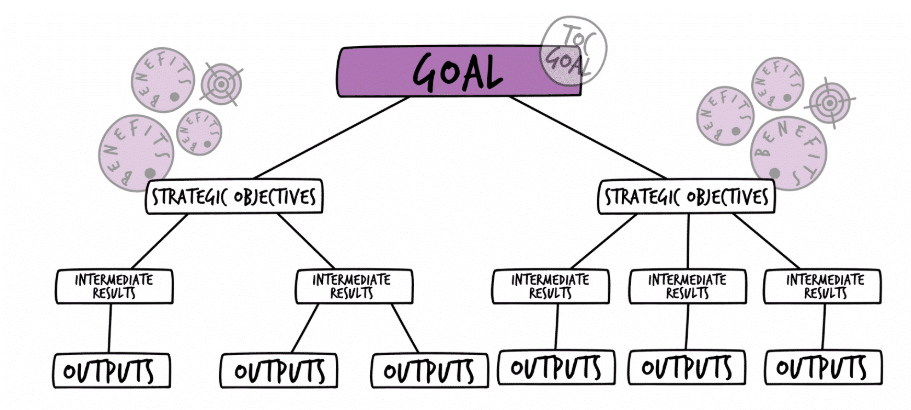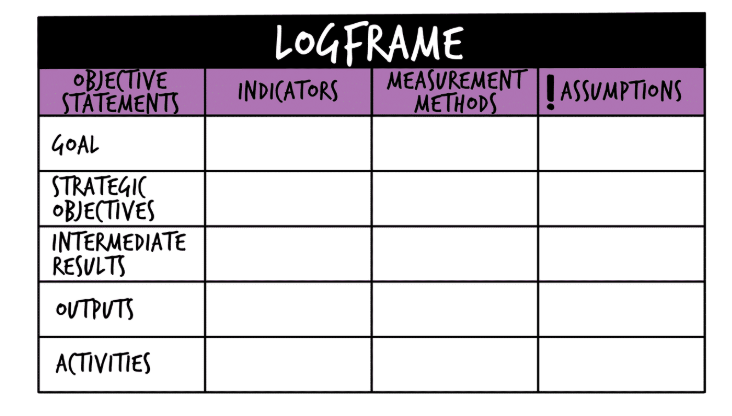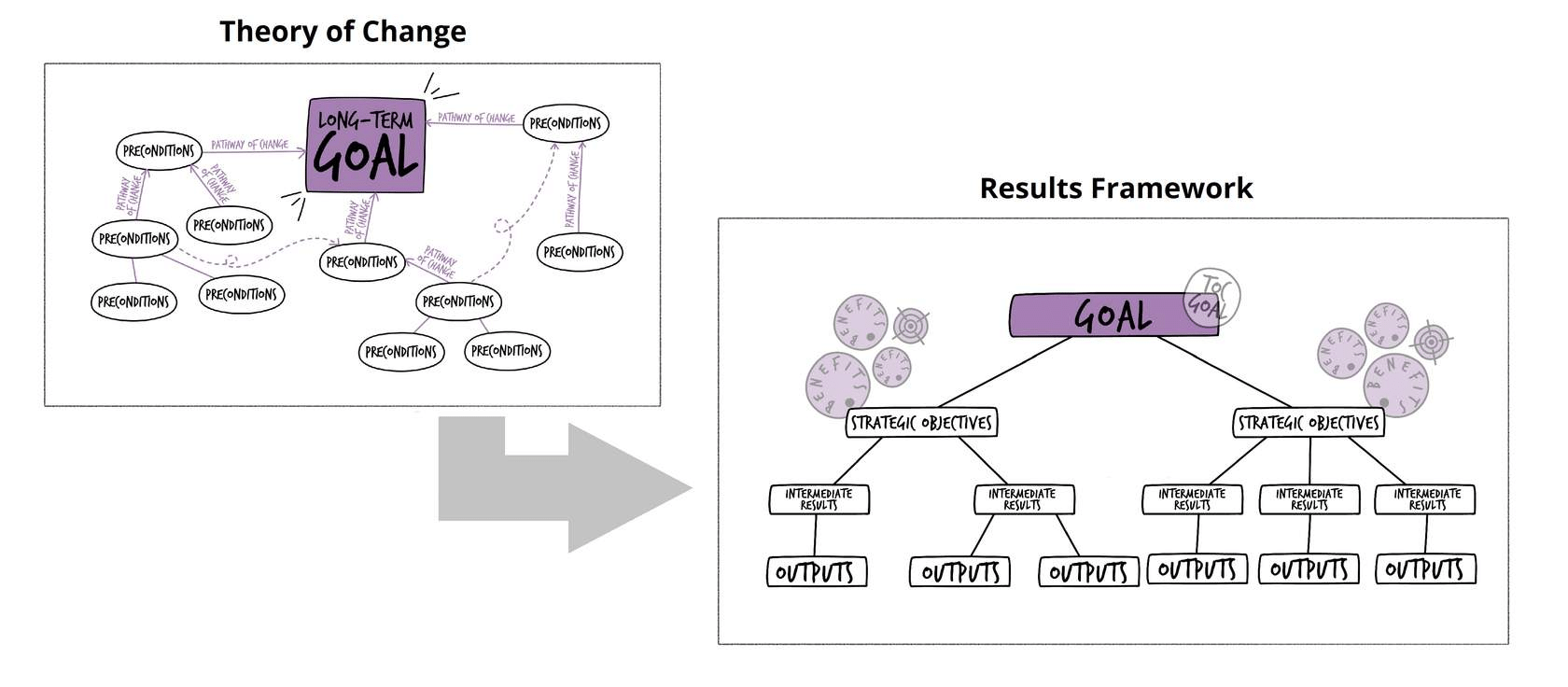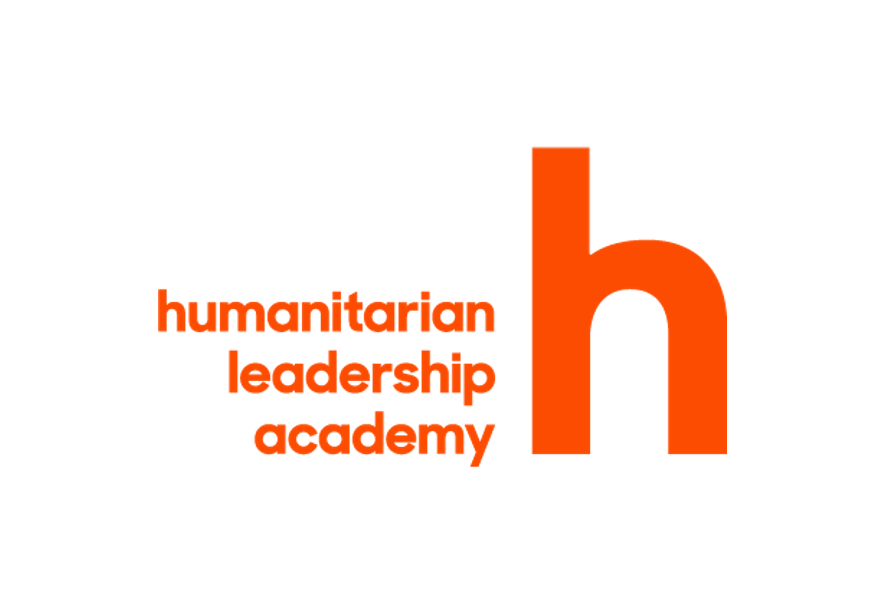Results Framework and Logframe
I want to model how my project will achieve its objectives and measure progress...
What are they?
Results frameworks and logical frameworks (logframes) are the second and third logic models recommended by the Guide to the MEAL DPro as you “map out” the logic of your project. Like the theory of change, these logic models provide a visual representation of the identified need and the changes you want to see happen through the project.
However, unlike the theory of change, results frameworks and logframes focus only on the work that is the direct responsibility of the project.
Results Framework
The results framework (RF) organizes the expected results of a project into a series of “if-then” relationships. The statements used in the RF thus articulate the project’s hierarchy of objectives and describe the vertical logic of the project. In other words, they describe the logic of: “If we do this, then this will happen.”
Different organizations may choose to use different terminology and different formats for results frameworks. The Guide to the MEAL DPro uses the following structure and terminology to organize its objective statements: Goal, Strategic Objectives, Intermediate Results, and Outputs.
Goal
Goal describes the longer-term, wider development to which the project contributes. Goal statements are usually aspirational, focusing on states of sustainability, livelihood, well-being, etc.
Strategic Objectives (SOs)
Strategic Objectives (SOs) express the central purpose of the project. They describe the significant benefits that are anticipated by the end of the project. In most cases, the SOs address the immediate causes of the core problem.
Intermediate Results (IRs)
Intermediate Results (IRs) statements express the expected change(s) in behaviors, systems, policies or institutions as a result of project outputs and activities.
Outputs
Outputs statements specify the deliverables resulting from project activities. They include products, goods, services, knowledge, skills and attitudes. (e.g. people trained with increased knowledge and skill; quality roads built).
In summary, the RF tells the reader, “if we complete these outputs, our intermediate results will be achieved, which will lead to achievement of our strategic objectives, and contribute to our long-term goal.”

Logframe
The logframe is the third, and most specific, logic model. It is a visual representation of the project that describes its key features and the specific logical linkages between them. Like the theory of change and the RF, the logframe is intended to communicate the purpose and main components of a project as clearly and simply as possible.
Logframe templates can also vary from organization to organization, donor to donor. The MEAL DPro uses the following logframe template:

How do I use them?
Results Framework
The Results Framework is created by making sometimes difficult decisions about which theory of change components will be included in your project. This requires thinking about:
- Which needs have highest priority
- Which needs your organization has the capacity and resources to tackle
- Which needs fit with your agency priorities.
When these decisions are made, the results framework is created by organizing the chosen statements from the theory of change into the results framework format. Often, the long-term change becomes the goal, domains of change become strategic objectives, and other preconditions become intermediate results and outputs.

As you create the results framework, make sure that each statement is related to the one above or below it. The vertical hierarchy of a results framework means that reading down from the goal statement will tell you how a project plans to achieve the goal. Reading up from the outputs will help you understand why a lower-level result is needed to complete the next, higher-level level result. Thus, the results framework builds out the project’s hierarchy of objectives.
Logframe
When you have completed your RF, you are ready to begin the more detailed process of creating a project logframe.
First, copy the hierarchy of objectives from the results framework into the logframe template. You can also copy the appropriate assumptions from the theory of change into the logframe. It may be the case that you are working on your logframe some time after your results framework has been created. Creating a logframe is a good time to revisit those results statements and assumptions to make sure they are still appropriate.
The hierarchy of objectives in a logframe also includes project activities, which were not created for the results framework. This is an opportunity for you to think carefully about specific project activities.
Then, to complete the logframe, you make important decisions about which indicators and measurement methods will be used to measure project success and gather project data. These components are covered in more detail in the MEAL DPro Starter pages related to indicators and measurement methods.
When do I use them?
Results frameworks and logframes should be part of the project design process and are created before a project begins. They are often required by donors as part of project proposals.
Best practice recommends that results frameworks and logframes be treated as living documents. If your team changes the underlying logic of the project based on new information about the project context or changes in the project operating environment, then the results framework and the logframe should be updated.
Tips:
Tip 1:Refine the Objectives Statements
As you refine the statements created for the theory of change to use in the RF, be sure include information indicating:
- Who changes? Individuals? Communities? Populations? Governments? Institutions?
- What changes? Coverage? Behavior? Knowledge? Technologies?Models? Data? Systems? Policies?
- What is the direction or nature of the change? Increased? Decreased? Improved? Reduced? Adopted? Established? Used? Integrated?
Tip 2:Write all objective statements clearly
Use full sentences and try to avoid clauses that explain how change will happen. Explanatory clauses usually relate to the objective statements found at the next level down in the objectives hierarchy.

Supported by:
Shared by:
Users are free to copy/redistribute and adapt/transform
for non-commercial purposes.
© 2022 All rights reserved.




